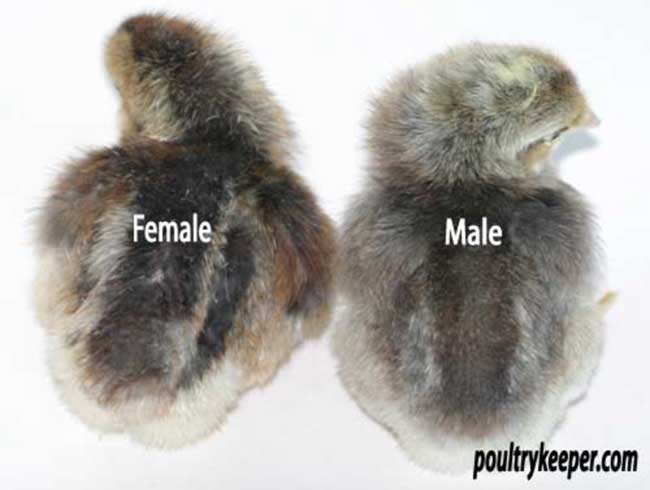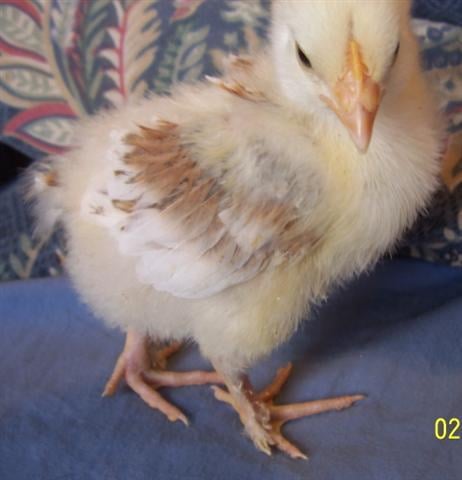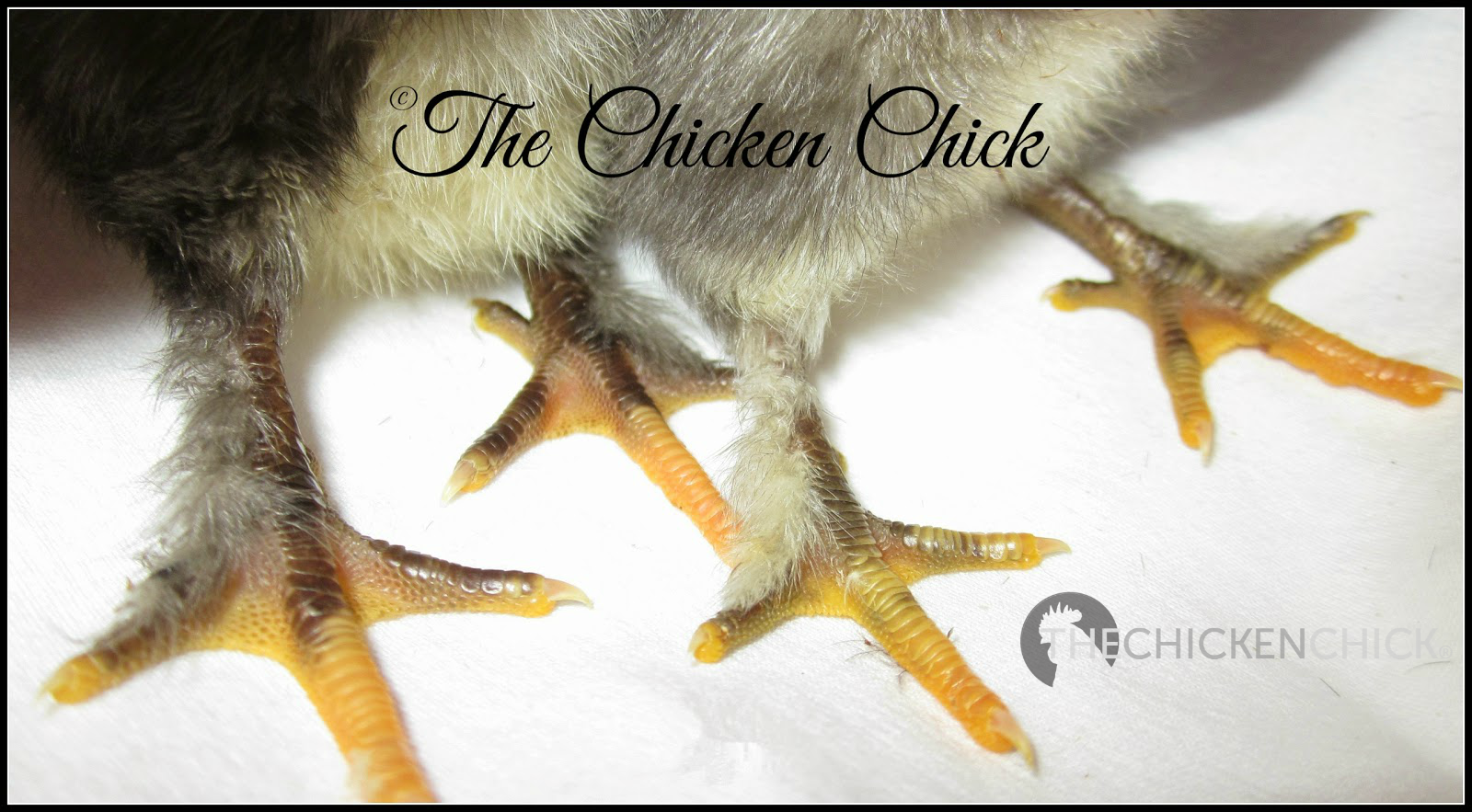Trying to decide whether your poultry is male or female is a source of great discussion and debate here on BYC so I have compiled the best ways to determine your chicken's sex from the day the hatch to the day they begin laying or crowing (AKA a dead give-away!).
Chicks
Auto-Sexing
Some types of chickens can be sexed at hatch. Some pure breeds are auto-sexing which means that when they hatch their markings can be used to determine their gender. For example, female Welsummer or Cream Legbar chicks have darker and more defined markings such as eyeliner and head triangles.


Sex-Links
Some other chickens are sex-links can be sexed at hatch because they are the result of certain cross breeds. Colour sexing is a tried and tested method of clarifying a chick’s gender. They can be easily sexed because males and females feather out very differently and often have different coloured downs at hatch. There are two well-known types: Black Sex-links and Red Sex-links.


Information on creating your own sex-links:
https://www.backyardchickens.com/t/261208/sex-linked-information


Feathering
As well as feathering in different colours, male chickens have also been noted to feather slower than females and in different areas – like many sexing methods, it isn’t 100% accurate so bear that in mind!
In breeds such as Wheaten Marans, the males’ wing feathers that grow in are much darker than female’s so can be used to verify their gender.

Male Wheaten vs Female Wheaten
Vent Sexing
Vent sexing is exactly what it sounds like - with proper training it is possible to verify a chick’s gender by looking at their vent. This is done by gently opening the vent and examining it to determine the chick’s gender. Their different sex organs are slightly different shapes and from what I can gather it is a very difficult method and isn’t usually attempted by novices – not to mention I don’t particularly want to look inside my chick’s vent!
Comb
Comparing the combs on your chicks is a great way to establish their gender. In general, a male’s comb is wider at the base and grows larger faster than a female of the same breed (although this is breed reliant because of the different comb types and sizes). It should also get redder faster.


Leg Size and Overall Stature
Male chicks are also supposes to have noticeably thicker legs than female chicks as well as growing to be larger and heavier than hens.


See the difference in thickness!
Feather Sexing in Chickens over 14 weeks
After around 14 weeks (this can vary!) chickens begin to grown different types of feathers depending on their gender. Roosters start to develop Sickle, Saddle and Hackle Feathers but females do not.
Sickle Feathers develop at the tail and are long and curved throughout. Hackle feathers are situated at the base of neck and are pointed at the tip, female neck feathers are always curved at the tip. Saddle feathers are situated at the lower back and hang below the contours of the body with a pointed tip.



Thank you for reading, let me know if you think I missed anything out!
Silkie Sexing Sexing Silkies is notoriously difficult due to their comb type and their unique fluffy feathers. The only type I am aware of that can be sexed by looking at their feather's development and colour is the Partidge Silkie. Apart from that you are in for a difficult (but possible!) task! Signs you have a rooster are as follows: At around 4-6 months of age, roosters develop thin, pointed feathers on their crest known as 'streamers'. Female Silkies never grow these feathers so they are a useful tool to use to dictate gender. Hen :
 Rooster:
Rooster:
 Behaviour and stance are also helpful tools in determining their sex. Silkie rooster (as well as rooster from many other breeds) have a tendency to be more boisterous and are usually top of the pecking order. In addition, male Silkies hold themselves much more upright than Silkie pullets. They will also develop male only feathers I mentioned earlier such as hackle, silkle and saddle feathers. A fully grown Cockerel :
Behaviour and stance are also helpful tools in determining their sex. Silkie rooster (as well as rooster from many other breeds) have a tendency to be more boisterous and are usually top of the pecking order. In addition, male Silkies hold themselves much more upright than Silkie pullets. They will also develop male only feathers I mentioned earlier such as hackle, silkle and saddle feathers. A fully grown Cockerel :
 Another sign I talked about earlier is comb development. In general, male Silkies have much larger walnut combs than their female counterparts when they have matured. Some Silkies also have wattles although the bearded variety do not.
Another sign I talked about earlier is comb development. In general, male Silkies have much larger walnut combs than their female counterparts when they have matured. Some Silkies also have wattles although the bearded variety do not.
Chicks
Auto-Sexing
Some types of chickens can be sexed at hatch. Some pure breeds are auto-sexing which means that when they hatch their markings can be used to determine their gender. For example, female Welsummer or Cream Legbar chicks have darker and more defined markings such as eyeliner and head triangles.


Sex-Links
Some other chickens are sex-links can be sexed at hatch because they are the result of certain cross breeds. Colour sexing is a tried and tested method of clarifying a chick’s gender. They can be easily sexed because males and females feather out very differently and often have different coloured downs at hatch. There are two well-known types: Black Sex-links and Red Sex-links.
Information on creating your own sex-links:
https://www.backyardchickens.com/t/261208/sex-linked-information


Feathering
As well as feathering in different colours, male chickens have also been noted to feather slower than females and in different areas – like many sexing methods, it isn’t 100% accurate so bear that in mind!
In breeds such as Wheaten Marans, the males’ wing feathers that grow in are much darker than female’s so can be used to verify their gender.

Male Wheaten vs Female Wheaten
Vent Sexing
Vent sexing is exactly what it sounds like - with proper training it is possible to verify a chick’s gender by looking at their vent. This is done by gently opening the vent and examining it to determine the chick’s gender. Their different sex organs are slightly different shapes and from what I can gather it is a very difficult method and isn’t usually attempted by novices – not to mention I don’t particularly want to look inside my chick’s vent!
Comb
Comparing the combs on your chicks is a great way to establish their gender. In general, a male’s comb is wider at the base and grows larger faster than a female of the same breed (although this is breed reliant because of the different comb types and sizes). It should also get redder faster.

Leg Size and Overall Stature
Male chicks are also supposes to have noticeably thicker legs than female chicks as well as growing to be larger and heavier than hens.


See the difference in thickness!
Feather Sexing in Chickens over 14 weeks
After around 14 weeks (this can vary!) chickens begin to grown different types of feathers depending on their gender. Roosters start to develop Sickle, Saddle and Hackle Feathers but females do not.
Sickle Feathers develop at the tail and are long and curved throughout. Hackle feathers are situated at the base of neck and are pointed at the tip, female neck feathers are always curved at the tip. Saddle feathers are situated at the lower back and hang below the contours of the body with a pointed tip.


Thank you for reading, let me know if you think I missed anything out!
Silkie Sexing Sexing Silkies is notoriously difficult due to their comb type and their unique fluffy feathers. The only type I am aware of that can be sexed by looking at their feather's development and colour is the Partidge Silkie. Apart from that you are in for a difficult (but possible!) task! Signs you have a rooster are as follows: At around 4-6 months of age, roosters develop thin, pointed feathers on their crest known as 'streamers'. Female Silkies never grow these feathers so they are a useful tool to use to dictate gender. Hen :
